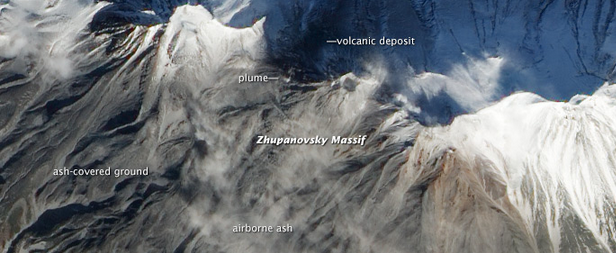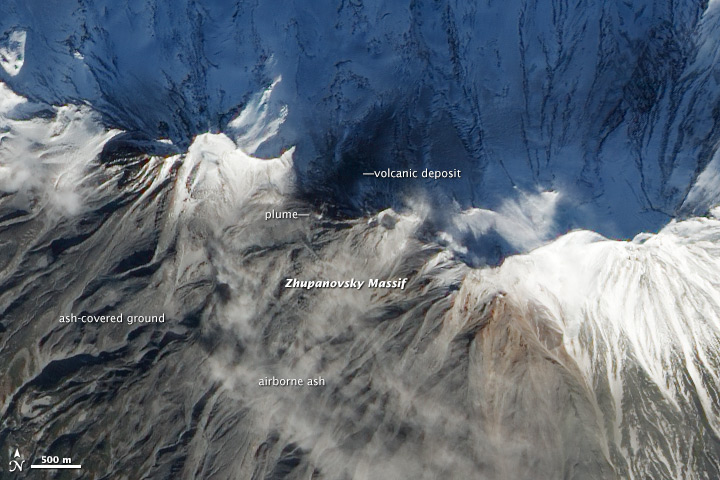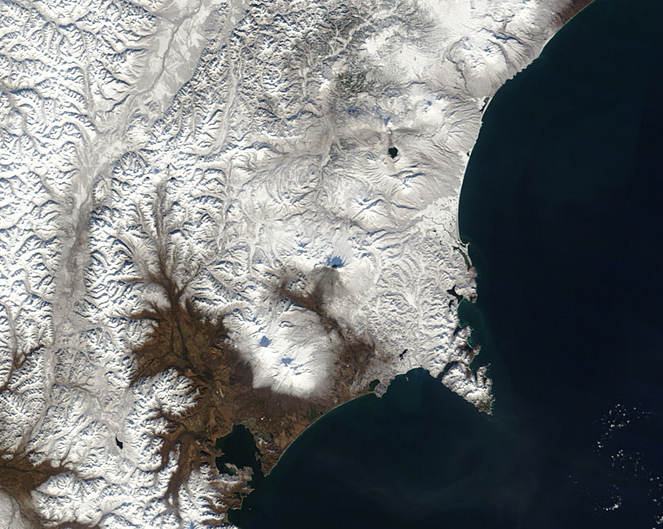Zhupanovsky volcano awakens after 54 years of sleep, Kamchatka

There are subtle signs of a new eruption brewing at Zhupanovsky volcano on Russia’s Kamchatka Peninsula which was quiet since 1959. The Earth-Observing 1 satellite captured ash above Zhupanovsky on November 5, 2013.
According to the Global Volcanism Program (GVP) the explosions at Zhupanovksy are phreatic, caused by the nearly instantaneous vaporization of water with hot material below the surface.

NASA Earth Observatory image by Jesse Allen and Robert Simmon, using EO-1 ALI data from the NASA EO-1 team.
Latest entry to GVP weekly volcano reports for Zhupanovsky was on the week of October 23 – 29, 2013:
KVERT reported that a weak thermal anomaly over Zhupanovsky was detected on October 23. The next day a phreatic eruption began at about 03:00 and generated an ash plume that rose 5 km (16 400 ft) a.s.l. The ash plume was visible in satellite images drifting 40 km SE and S. Ash deposits about 10 cm thick were visible at the summit of the central part of the volcano, and deposits about 1 mm thick covered the Nalychevo Valley. The Aviation Color Code was raised to Orange.
Ash plumes at 16:35 and 22:18 rose to altitudes of 2.5-3 km (8 200 – 10 000 ft) a.s.l. and drifted 120 km ESE and 25 km S, respectively. At 11:34 on October 25 an ash plume rose 3 km (10,000 ft) a.s.l. and drifted 20 km NE. On October 27 KVERT noted that strong fumarolic activity and gas emissions continued, but that the phreatic explosions likely had ceased. The Aviation Color Code was lowered to Yellow, and then lowered again to Green on October 29.

On October 26, 2013, the Moderate Resolution Imaging Spectroradiometer (MODIS) aboard the Terra satellite spied a streak of dark material on Zhupanovsky’s north face. Image credit: MODIS
The Zhupanovsky volcanic massif consists of four overlapping stratovolcanoes along a WNW-trending ridge. The elongated volcanic complex was constructed within a Pliocene-early Pleistocene caldera whose rim is exposed only on the eastern side. Three of the stratovolcanoes were built during the Pleistocene, the fourth is Holocene in age and was the source of all of Zhupanovsky's historical eruptions.
An early Holocene stage of frequent moderate and weak eruptions from 7000 to 5000 years before present (BP) was succeeded by a period of infrequent larger eruptions that produced pyroclastic flows.
The last major eruption of Zhupanovsky took place about 800-900 years BP. Historical eruptions have consisted of relatively minor explosions from the third cone (GVP).
Sources: Earth Observatory, Global Volcanism Program
Featured image: Earth Observatory, EO-1 ALI

boom in the front